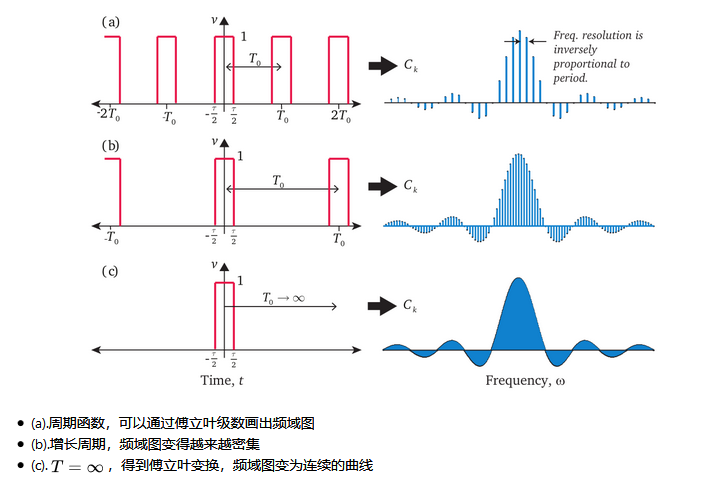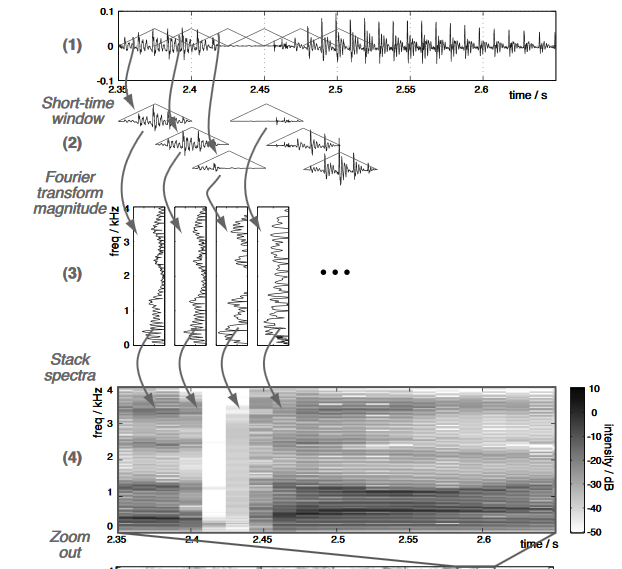参考An introduction to signal processing for speech,From Dan Ellis @ Columbia University,Chapter 22 in Handbook of Phonetic Science ,极好的入门引导,摘录+补充。
This chapter aims to give a transparent and intuitive introduction to the basic ideas of the Fourier domain and filtering, and connects them to some of the common representations used in speech science, including the spectrogram and cepstral coefficients.
关键词:傅里叶分析,滤波,时频图(spectrogram),倒谱系数
在介绍傅里叶分析之前,首先要理解一个重要的概念:线性,粗略来说就是系统的输出是随着输入同步缩放的。
Very roughly, linearity is the idea that scaling the input to a system will result in scaling the output by the same amount.
正弦函数就是线性系统的一个特征函数(也就是说正弦函数是满足线性特征的)。
Now we can learn one more very important property of sinusoids: they are the eigenfunctions of linear systems. What this means is that if a linear system is fed a sinusoid (with or without an exponential envelope), the output will also be a sinusoid, with the same frequency and the same rate of exponential decay, merely scaled in amplitude and possibly shifted in phase.
这里要稍微解释一下,参考什么是特征函数?
我们把没有给出具体解析式的函数称为抽象函数。而特征函数是相对于抽象函数而言的,是满足一定(特征)条件的具体函数,表现形式是一个具体函数。
比如f(xy)=f(x)+f(y)没有给出具体的函数表达形式,只是给出了相应的函数性质,是一个抽象函数。而满足该性质的一个具体函数被称为特征函数,比如 f(x)=ln(x) 就是它的一个特征函数,观察函数性质可知该特征函数集合是对数函数。
线性所带来的重要而精妙的特性之一就是叠加性(superposition)。
正弦输入正弦输出+叠加性,is the key to the value of Fourier transform.
下面正式引入傅里叶分析,首先看看periodically-repeating波形的情况:
The core of Fourier analysis is a simple but somewhat surprising fact: Any periodically-repeating waveform can be expressed as a sum of sinusoids, each scaled and shifted in time by appropriate constants. Moreover, the only sinusoids required are those whose frequency is an integer multiple of the fundamental frequency of the periodic sequence.
那么,该如何去求a sum of sinusoids呢?这也就是如何求傅里叶级数。(原文这段大致解释了做内积的原理,推荐看这个遗迹系列 -【学渣告诉你】到底神马是傅里叶级数!,白话易懂,关键点在于“将一个函数用一堆基函数表示”和“将一个向量用一堆基向量表示”这两件事情是类似的)
It turns out that finding the Fourier series coefficients – the optimal scale constants and phase shifts for each harmonic – is very straightforward: All you have to do is multiply the waveform, point-for-point, with a candidate harmonic, and sum up (i.e. integrate) over a complete cycle; this is known as taking the inner product between the waveform and the harmonic, and gives the required scale constant for that harmonic. This works because the harmonics are orthogonal, meaning that the inner product between different harmonics is exactly zero, so if we assume that the original waveform is a sum of scaled harmonics, only the term involving the candidate harmonic appears in the result of the inner product. Finding the phase requires taking the inner product twice, once with a cosine-phase harmonic and once with the sine-phase harmonic, giving two scaled harmonics that can sum together to give a sinusoid of the corresponding frequency at any amplitude and any phase.
求傅里叶级数即是做傅里叶分析,反之,傅里叶合成就是将傅里叶级数转化为波形。
但是如果傅里叶分析只对periodically-repeating波形有效,那就没太大意义了,因为纯周期信号(在无限时间上周期循环)只是一个数学抽象,在现实世界中并不存在。怎么办呢?
Consider, however, stretching the period of repetition to be longer and longer. Fourier analysis states that within this very long period we can have any arbitrary and unique waveform, and we will still be able to represent it as accurately as we wish. All that happens is that the ‘harmonics’ of our very long period become more and more closely spaced in frequency.
关键点就在于stretching the period of repetition,参考从傅立叶级数到傅立叶变换:

Now by letting the fundamental period go to infinity, we end up with a signal that is no longer periodic, since there is only space for a single repetition in the entire real time axis; at the same time, the spacing between our harmonics goes to zero, meaning that the Fourier series now becomes a continuous function of frequency, not a series of discrete values. However, nothing essentially changes – and, in particular, we can still find the value of the Fourier transform function simply by calculating the inner product integral. Now we have the most general form of the Fourier transform, pairing a continuous, non-repeating (aperiodic) waveform in time, with a continuous function of frequency.
人类听觉系统其实就像是在做傅里叶变换,通过耳蜗(可以视为一组滤波器)将时域声压转换为独立的不同频率的分量,但是,准确地说,更接近于短时傅里叶变换(STFT)。关于STFT,参考能不能通俗的讲解下傅立叶分析和小波分析之间的关系?:
傅里叶变换处理非平稳信号(频率随时间变化的信号)有天生缺陷。它只能获取一段信号总体上包含哪些频率的成分,但是对各成分出现的时刻并无所知。因此时域相差很大的两个信号,可能频谱图一样。
对于这样的非平稳信号,只知道包含哪些频率成分是不够的,我们还想知道各个成分出现的时间。知道信号频率随时间变化的情况,各个时刻的瞬时频率及其幅值——这也就是时频分析。
一个简单可行的方法就是——加窗。我又要套用方沁园同学的描述了,“把整个时域过程分解成无数个等长的小过程,每个小过程近似平稳,再傅里叶变换,就知道在哪个时间点上出现了什么频率了。”这就是短时傅里叶变换。
我们在时频图(spectrogram,不是频谱spectrum,频谱是不带有时域信息的)上所看到的实际上就是STFT的幅值。
Calculation of the spectrogram. Input signal (1) is converted into a sequence of short excerpts by applying a sliding tapered window (2). Each short excerpt is converted to the frequency domain via the Fourier transform (3), then these individual spectra become columns in the spectrogram image (4), with each pixel’s color reflecting the log-magnitude at the corresponding frequency value in the Fourier transform.
(Linear Prediction暂时略过)
然而,spectrum和spectrogram中所包含的信息太多,实际应用中并不需要那么多的细节,更重要的是提取其中的关键特征。
在语音识别中最为常用的特征就是Mel-frequency cepstral coefficients(MFCC)。
要理解MFCC,可以从两个方面进行:(1)什么是Mel-frequency scale?(2)什么是倒谱系数cepstral coefficients?
(1)什么是Mel-frequency scale?
The Mel-frequency scale is a nonlinear mapping of the audible frequency range. The scale is approximately linear below 1000 Hz and approximately logarithmic above 1000Hz.
(2)什么是倒谱系数cepstral coefficients?
Cepstra amounts to taking a second Fourier transform on the logarithm of the magnitude of the original spectrum (Fourier transform of the time waveform). Because of the symmetry between time and frequency in the basic Fourier mathematics, without the intervening log-magnitude step, taking the Fourier transform of a Fourier transform almost gets you back to the original signal. But taking the magnitude removes any phase (relative timing) information between different frequencies, and applying a logarithm drastically alters the balance between intense and weak components, leading to a very different signal.
那么,MFCC就是在Mel-warped spectrum上求cepstra了。
当然还有其他的一些特征,比如:
Perceptual Linear Prediction (PLP)
PLP features often perform comparably to MFCCs, although which feature is superior tends to vary from task to task. PLP features use the Bark auditory scale, and trapezoidal (flat-topped) rather than triangular windows, to create the initial auditory spectrum. Then, rather than smoothing the auditory spectrum by keeping only the low-order cepstral coefficients, linear prediction is used to find a smooth spectrum consisting of only a few resonant peaks (typically 4 to 6) that matches the Bark-spectrum.Finally, this smoothed PLP spectrum is again converted to the compact, decorrelated cepstral coefficients via another neat mathematical trick that finds cepstra directly from an LP model.
delta coefficients
an estimate of the local slope, along the direction of the time axis, for each frequency or cepstral coefficient
Cepstral Mean Normalization (CMN)
the average value of each cepstral dimension over an entire segment or utterance is subtracted from that dimension at every time step
另外一些不错的资料:
zouxy09的专栏
小腹黑zju的博客
傅里叶级数和傅里叶变换是什么关系?
如何理解傅里叶变换公式?
CMU Speech Processing
爱丁堡大学Automatic Speech Recognition
哥伦比亚大学Speech and Audio Processing and Recognition
TAMU Speech processing
MIT Linguistic Phonetics
语谱图,滤波器组(Filter banks、MFCC),介绍了MFCC具体的求法























 6718
6718











 被折叠的 条评论
为什么被折叠?
被折叠的 条评论
为什么被折叠?








